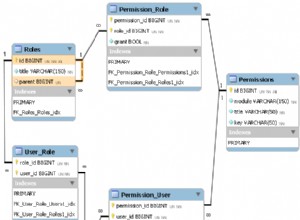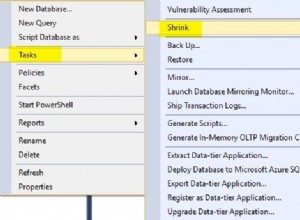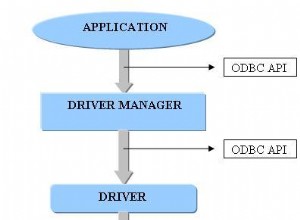Tôi tin rằng bạn đang tìm kiếm tham số có giá trị của bảng Bạn có thể điền nó từ một tập dữ liệu và, giả sử bạn không làm điều gì đó ngớ ngẩn khi chuyển nó đến SQL Server, thì nó sẽ được coi là một hoạt động nguyên tử - tất cả đều đi vào hoặc không.
IF EXISTS
(
SELECT
*
FROM
sys.types T
WHERE
T.name = 'CONTRIVED_EXAMPLE'
)
BEGIN
PRINT 'Dropping type dbo.CONTRIVED_EXAMPLE'
DROP TYPE dbo.CONTRIVED_EXAMPLE
END
PRINT 'Creating type dbo.CONTRIVED_EXAMPLE'
GO
-----------------------------------------------------------------------------
-- Type: dbo.CONTRIVED_EXAMPLE
-- Author: Bill Fellows
-- Date: 2010-06-07
--
-- This is a user-defined table type demonstrating the syntax
-- for a table valued parameter
--
-- See also:
--
-- Modified:
--
-----------------------------------------------------------------------------
CREATE TYPE
dbo.CONTRIVED_EXAMPLE AS TABLE
(
twitter_handle varchar(15) NOT NULL
, have_met bit NOT NULL
)
GO
IF EXISTS
(
SELECT
*
FROM
sys.tables T
WHERE
T.name = 'CONTRIVED_EXAMPLE_TABLE'
)
BEGIN
PRINT 'Dropping type dbo.CONTRIVED_EXAMPLE_TABLE'
DROP TABLE dbo.CONTRIVED_EXAMPLE_TABLE
END
PRINT 'Creating table dbo.CONTRIVED_EXAMPLE_TABLE'
GO
-----------------------------------------------------------------------------
-- Type: dbo.CONTRIVED_EXAMPLE_TABLE
-- Author: Bill Fellows
-- Date: 2010-06-07
--
-- This is a boring table demonstrating the syntax
-- for a table valued parameter
--
-- See also:
--
-- Modified:
--
-----------------------------------------------------------------------------
CREATE TABLE
dbo.CONTRIVED_EXAMPLE_TABLE
(
row_id int identity(1,10) NOT NULL PRIMARY KEY
, twitter_handle varchar(15) NOT NULL
, have_met bit NOT NULL
)
GO
IF EXISTS
(
SELECT
SO.*
FROM
dbo.sysobjects SO
WHERE
SO.id = OBJECT_ID('dbo.EchoBack')
AND OBJECTPROPERTY(SO.id, 'IsProcedure') = 1
)
BEGIN
PRINT 'Dropping stored procedure dbo.EchoBack'
DROP PROCEDURE dbo.EchoBack
END
GO
PRINT 'Creating stored procedure dbo.EchoBack'
GO
-----------------------------------------------------------------------------
-- Function: dbo.EchoBack
-- Author: Bill Fellows
-- Date: 2010-06-07
--
-- This procedure handles merging
--
-- Recordsets:
-- The contents of our table valued parameter will be echoed back to the
-- caller.
--
-- Side-effects:
-- None
--
-- See also:
-- your mom
--
-- Modified:
--
-----------------------------------------------------------------------------
CREATE PROCEDURE dbo.EchoBack
(
@tvp dbo.CONTRIVED_EXAMPLE READONLY
)
AS
BEGIN
SET NOCOUNT ON
SELECT
T.*
FROM
@tvp T
END
GO
PRINT 'Granting rights for dbo.EchoBack'
GRANT EXECUTE ON dbo.EchoBack TO public
GO
DECLARE @p1 dbo.CONTRIVED_EXAMPLE
INSERT INTO @p1 values('billinkc', 1)
INSERT INTO @p1 values('peschkaj', 1)
INSERT INTO @p1 values('mikeSQL', 1)
INSERT INTO @p1 values('SQLChicken', 0)
SELECT * FROM @p1
EXECUTE dbo.EchoBack @p1
GO
IF EXISTS
(
SELECT
SO.*
FROM
dbo.sysobjects SO
WHERE
SO.id = OBJECT_ID('dbo.TwitterAdd')
AND OBJECTPROPERTY(SO.id, 'IsProcedure') = 1
)
BEGIN
PRINT 'Dropping stored procedure dbo.TwitterAdd'
DROP PROCEDURE dbo.TwitterAdd
END
GO
PRINT 'Creating stored procedure dbo.TwitterAdd'
GO
-----------------------------------------------------------------------------
-- Function: dbo.TwitterAdd
-- Author: Bill Fellows
-- Date: 2010-06-07
--
-- This procedure handles merging
--
-- Recordsets:
-- Business rule violations (optional)
--
-- Side-effects:
-- 0-N rows written to twitter table
--
-- See also:
-- CONTRIVED_EXAMPLE (your mom)
--
-- Modified:
--
-----------------------------------------------------------------------------
CREATE PROCEDURE dbo.TwitterAdd
(
@tvp dbo.CONTRIVED_EXAMPLE READONLY
)
AS
BEGIN
SET NOCOUNT ON
MERGE
dbo.CONTRIVED_EXAMPLE_TABLE DESTINATION
USING
(SELECT twitter_handle, have_met FROM @tvp T) AS SOURCE (twitter_handle, have_met)
ON (SOURCE.twitter_handle = DESTINATION.twitter_handle)
-- Never forget I met someone
WHEN MATCHED AND DESTINATION.have_met = 0
THEN UPDATE SET DESTINATION.have_met = SOURCE.have_met
WHEN NOT MATCHED
THEN INSERT(twitter_handle, have_met) VALUES (SOURCE.twitter_handle, SOURCE.have_met)
-- merge statements must be terminated by a semi-colon
-- and don't you forget it!
;
END
GO
PRINT 'Granting rights for dbo.TwitterAdd'
GRANT EXECUTE ON dbo.TwitterAdd TO public
GO
Tại thời điểm này, bạn có thể thấy TVP hoạt động như thế nào. Bước còn lại duy nhất là gắn nó vào mã .NET của bạn. Một cái gì đó giống như
/// <summary>
/// This method demonstrates the ease of passing a dataset in
/// as a TVP
/// </summary>
public static void TSQLTuesday007()
{
string connectionString = @"Data Source=localhost;Initial Catalog=master;Integrated Security=True";
System.Data.SqlClient.SqlConnection conn = new System.Data.SqlClient.SqlConnection(connectionString);
System.Data.DataTable dataTable = null;
// note that my data table does not have to be the same
// as my UDTT, nor do my columns have to have the same name
// Types-yes. Ordinal, probably so
dataTable = new System.Data.DataTable("Sample");
dataTable.Columns.Add("tweep", System.Type.GetType("System.String"));
dataTable.Columns.Add("have_met", System.Type.GetType("System.Boolean"));
// add rows to my data table but really, this could be any source
dataTable.Rows.Add(new object[] { "billinkc", true });
dataTable.Rows.Add(new object[] { "BrentO", true });
dataTable.Rows.Add(new object[] { "buckwoody", false });
// Hooray for #sqlsat35 and meeting Jen & Sean
dataTable.Rows.Add(new object[] { "MidnightDBA", true });
System.Data.SqlClient.SqlConnection connection = null;
System.Data.DataSet results = null;
System.Data.SqlClient.SqlCommand command = null;
System.Data.SqlClient.SqlDataReader dataReader = null;
connection = new System.Data.SqlClient.SqlConnection(connectionString);
try
{
connection.Open();
command = new System.Data.SqlClient.SqlCommand("TwitterAdd");
command.CommandType = System.Data.CommandType.StoredProcedure;
command.Connection = connection;
// Assigning a table valued parameter looks much like any other parameter
System.Data.SqlClient.SqlParameter tvp = command.Parameters.AddWithValue("@tvp", dataTable);
// this is the only special sauce (not required but helpful)
tvp.SqlDbType = System.Data.SqlDbType.Structured;
tvp.TypeName = "dbo.CONTRIVED_EXAMPLE";
dataReader = command.ExecuteReader();
if (dataReader.HasRows)
{
results = new System.Data.DataSet();
results.Tables.Add();
results.Tables[0].Load(dataReader);
// PPrint(results);
}
}
catch (Exception ex)
{
Console.WriteLine(ex);
}
}




